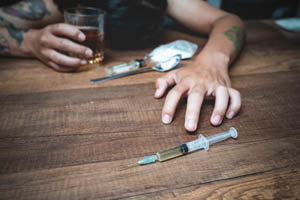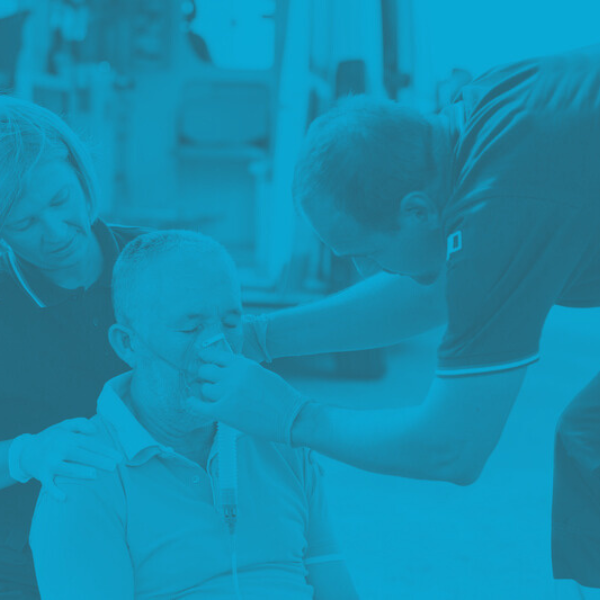How the Opioid Algorithm Saves Lives
How the Opioid Algorithm Saves Lives

by Greta Kviklyte
Life Saver, AMC
Co-authored by Kim Murray, RN, M.S.
posted on Nov 22, 2019, at 3:59 am
The opioid epidemic represents a grave threat to society. Opioids cost the lives of more than 70,000 people in the U.S. in 2017. Around the globe, opioids continue to shatter lives. According to the World Health Organization (WHO), 34 million people used opioids in 2016, and approximately 450,000 people died. Unfortunately, the life-saving measures used to combat an opioid overdose, part of the opioid algorithm, remain out of reach for millions. Out of the thousands of people that overdose on opioids, less than 10% receive the come-back-to-life drug, naloxone. The problem is severe, and the only solution is to understand how to respond to those in need, in the throes of an overdose, and why immediate intervention, including the use of life-saving skills, as shown in the courses here, is key to survival.
We offer Online ACLS, PALS and BLS Certification and Renewal
What Opioids Caused the Epidemic
Prescription opioids, as well as black market opioids, lessen the respiratory rate and contribute to a higher mortality risk. Part of the problem derives from the perceived safety of opioids. According to the New York Times, such perception led to countless, legitimate uses for opioids. Yet, they came at a cost, and many grew dependent on the highly addictive chemicals. The writing was on the wall, but it was too late. By 2017, prescription rates for opioids dwindled, but more powerful, black market opioids, including fentanyl and heroin, replaced the traditional prescriptions. Now, those suffering with addiction amplify their risk with each pill, injection or substance.

These illicit substances pour into the U.S. from China and through Mexico. In a sense, the internet played a role in the worsening of the epidemic. In 2017, black market opioids were associated with more than 28,000 overdose cases, slightly more than half the total number of overdoses in the same year. With the risk on the rise, the courts look for a way to lessen the grip of the epidemic, and their focus shifted to the drug manufacturers. They are on the hook for multiple lawsuits, alleging their recklessness in promoting opioids as a safe solution to pain management have a legal ramification to the tune of $50 billion. Sadly, this number barely scratches the surface of the costs of the epidemic. To truly fight the problem, health care professionals, community leaders and members, politicians, educators, and corporations need to come together and understand the scope of the epidemic and how the opioid algorithm can save lives.
Opioid Overdose Risks Don’t Discriminate
 The risk of an opioid overdose was historically limited to those at a greater risk for receiving an opioid prescription to treat pain. In recent years, the faces of the epidemic shifted to Caucasian families, regardless of socioeconomic status, notes NPR.org. Experts disagree on why the epidemic seems to have targeted Caucasians, but it may have roots in the lack of access to care among minorities. Those without access to care may have never received an opioid prescription in the first place. Now, the NPR article was published in November 2017, and since that time, the mortality rates of the epidemic shifted closer to illicit opioids.
The risk of an opioid overdose was historically limited to those at a greater risk for receiving an opioid prescription to treat pain. In recent years, the faces of the epidemic shifted to Caucasian families, regardless of socioeconomic status, notes NPR.org. Experts disagree on why the epidemic seems to have targeted Caucasians, but it may have roots in the lack of access to care among minorities. Those without access to care may have never received an opioid prescription in the first place. Now, the NPR article was published in November 2017, and since that time, the mortality rates of the epidemic shifted closer to illicit opioids.
Anyone that takes opioids has an increased risk for becoming a victim of opioid overdose and substance use disorder.
For example, an assumption exists that higher dosages reduce pain more than lower dosages. As explained by the Centers for Disease Control and Prevention (CDC), higher dosages have never been found to be more effective than a more traditional dosage, 22-50 morphine milligram equivalents. Furthermore, the MME of each opioid prescription should reflect the needs of the patient, not just the threat of pain. In other words, prescribers need to focus more on long-term benefits versus short-term paid reduction. The solution is to avoid unintentional overdose and reduce the risk of encouraging the development of a substance use disorder. As a result, the solution, including the use of the opioid algorithm, must go beyond the physician’s office and delve into the community, including law enforcement and first responders.
First Responders Look to Reduce Mortality
The manufacturer of naloxone, reports Narcan.com, Emergent has taken the initiative to empower first responders to reduce opioid mortality. Instead of a traditional injection, the company developed a Narcan nasal spray, eliminating the risk of cross-contamination or unintended harm to victims of overdose. While police officers may have the training to perform life-saving measures, they may not have nursing or medical licenses. As a result, their skills are limited, but the new push for first responder-initiated use of the opioid algorithm, will help save lives.
Law enforcement professionals and those at risk for encountering people suffering an opioid overdose can save lives by administering naloxone. Opioids suppress the respiratory, nervous, and cardiac systems. The depressive effects increase several risks, including risk of choking, suffocation, accidental injury, and more.
Both Massachusetts and North Carolina have taken the steps to dispense free overdose rescue kits, containing naloxone, to first responders throughout communities. Unfortunately, the low-cost medication can be too far out of the budget for some organizations. As a result, Emergent has now implemented a program to allow a 40% discount off per carton of the medication for purchase by all first responders, including EMS, Fire Departments and Police.
Education and Awareness Are Critical to Fighting the Epidemic
The power of opioids is clear. The addictive substances are too great to fight by simply hoping for the best, and legal consequences to those responsible for their spread are part of the solution. Unfortunately, the severity of the epidemic worsens daily, and the education and awareness become the most useful tools for preventing its continued path of destruction. Knowing the opioid algorithm will further this cause, helping everyone involved or affected by the epidemic mitigate its life-costing risks.
How to Use the Opioid Algorithm
The American Heart Association (AHA) created the opioid algorithm in 2015 within the “Special Circumstances of Resuscitation” guidelines. The revision to the guidelines followed a revelation that opioid overdose became the leading cause of unintentional death within the 35- to 60-year-old age group. The new statistic meant opioids were costing more lives than motor vehicle collisions, so the AHA intervened.
The recommendations were updated to advise the use of naloxone and opioid overdose response education in any case involving suspected opioid overdose. The list of applicable populations affected by the revised guidelines was expansive. It was based on training for First Aid, as well as Basic Life Support (BLS) outside of the health industry. In other words, any professional with training in BLS or First Aid, as discussed in a past blog here, should know how to respond when someone presents with an opioid overdose.
In addition, the AHA recognized the value of advanced training for health professionals. This is where the opioid algorithm gets slightly more complicated, moving through the traditional ACLS algorithm, as taught within the course here, and combines it with the opioid algorithm. An opioid overdose becomes a type of reversible cause of arrest. So, a health professional could simply apply the opioid algorithm as part of the ACLS guidelines.
For those outside of the health industry, the opioid algorithm follows a simpler pathway, including these key steps:
- Assess and activate. When an opioid overdose is suspected, time is of the essence. Passersby should check for unresponsiveness and call for help. Do not leave the person alone. Someone should contact EMS, obtain an automated external defibrillator (AED) and naloxone. Of course, not all facilities will have an AED or naloxone on-site. During this step, the for both the respiration rate and circulation. Respirations are a full inhalation and exhalation, not gasping. Circulation is another topic. For adolescents that may have used opioids, the risk becomes more dangerous. Any pulse below 60 bpm warrants the initiation of CPR and chest compressions.
- Begin CPR. Starting CPR means administering chest compressions at a rate of 100 per minute, which is the same rate of the chorus in the song, “Stayin’ Alive” by the Bee Gees. Administer 30 chest compressions followed by two rescue breaths. If alone, continue to perform CPR for two minutes before attempting to get help or otherwise proceeding.
- Administer naloxone. Naloxone should be given as soon as possible. If multiple responders are available, one should administer the medication while the other performs CPR. Naloxone should be given as either a two-milligram intranasal spray or 0.4 milligram intramuscular injection. Obviously, those without advanced medical knowledge may not have the skills to administer the injection. If faced with uncertainty, it may be permissible to administer naloxone via injection into the buttock or thigh. Consult your facility’s specific policy. If uncertain about administering the injection, continue CPR until professional help arrives.
- Assess responsiveness. If the person responds, such as moving purposely, regaining consciousness, making intentional noises, speaks, or returns to regular breathing patterns, provide stimulation. Shake the victim, and ask, “Are you okay?” Continue to check for respirations and circulation until professional help arrives. If the person stops responding, repeat the naloxone administration. Also, naloxone may be administered every four minutes while attempting to resuscitate the victim.
- Continue CPR for unresponsive victims. If the person does not respond, continue CPR and administer naloxone in four-minute intervals. If the person does come to or become responsive, return to prior step of assessing and monitoring responsiveness. Even if the person does appear to have regained complete consciousness, do not leave the victim. Opioids can still cause respiratory failure at any point, especially if the opioids were ingested in pill form, as the body processes the substance.
Know the Opioid Algorithm, Boost Awareness, and Save Lives
The opioid algorithm provides a step-by-step list of instructions to address and care for someone suffering from an opioid overdose. Without immediate intervention and application of the opioid algorithm, the chances of death multiply. Those that work with at-risk populations or in public places should take the time to learn the opioid algorithm. It’s a relatively simple process, and it will save lives.
Have you ever seen or participated in the response to someone suffering from an opioid overdose? If so, share your thoughts, along with this article, to social media now. Remember the spread of information and awareness is a critical step to combating the opioid epidemic. Also, opioid addiction is a mental health disorder, so be kind. Those using opioids may truly be incapable of stopping without outside intervention. One more thing, remember to enroll in an opioid-inclusive, life-saving skills course, such as the one available here, to save even more lives.



